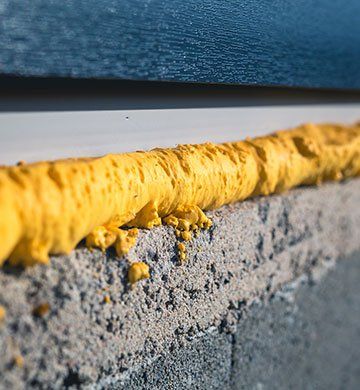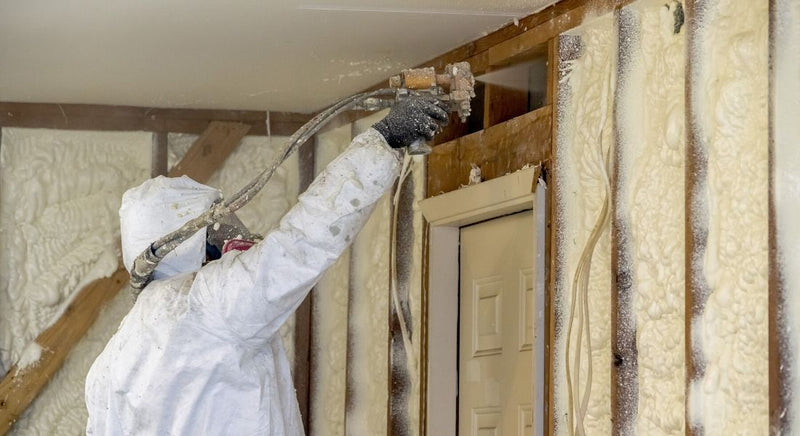The Ecological Impact of Spray Foam: Sustainability Factors To Consider
The Ecological Impact of Spray Foam: Sustainability Factors To Consider
Blog Article
Spray Foam: The Ultimate Solution for Air Sealing and Insulation
Spray foam insulation has actually emerged as a leading solution for effective air sealing and thermal insulation, using an one-of-a-kind combination of buildings that establish it apart from traditional techniques. Recognizing the full range of its benefits, installment procedures, and comparisons with various other insulation types is important for making educated choices.
What Is Spray Foam?
Spray foam is a versatile insulation material that combines the concepts of air sealing and thermal resistance to enhance power effectiveness in structures. Composed mainly of polyurethane or other similar substances, spray foam is used as a liquid that increases upon call with surfaces, developing a solid, constant layer of insulation. This one-of-a-kind building permits it to fill up spaces, splits, and voids that typical insulation materials may ignore, giving a remarkable air seal.
There are two primary types of spray foam: open-cell and closed-cell. Open-cell spray foam is lighter and a lot more adaptable, providing outstanding audio absorption and a reduced R-value per inch - Spray Foam. In comparison, closed-cell spray foam is denser, offering a greater R-value, wetness resistance, and added architectural stability to developing parts
The application process generally entails specific equipment, ensuring a smooth application that abides by numerous substrates, consisting of metal, timber, and concrete. This versatility makes spray foam appropriate for both brand-new buildings and retrofitting existing frameworks. Its capability to produce a closed obstacle substantially adds to lowering power usage and enhancing indoor air top quality, consequently making it a favored choice among home builders and house owners alike.
Benefits of Spray Foam Insulation
Among the most substantial benefits of spray foam insulation is its outstanding ability to develop a constant air obstacle, which efficiently decreases energy loss. Unlike traditional insulation products, spray foam broadens to fill spaces and cracks, making certain that air leak is drastically decreased. This characteristic not just boosts energy efficiency yet also causes reduce energy bills in time.
In addition, spray foam insulation supplies premium thermal resistance, adding to a more stable interior atmosphere. Its high R-value per inch allows for effective insulation in restricted rooms, making it excellent for attics, walls, and crawl rooms. The moisture-resistant buildings of spray foam assistance avoid mold and mildew and mold growth, advertising healthier living conditions.
Another crucial advantage of spray foam insulation is its sound-dampening top qualities (Spray Foam). It properly minimizes sound transmission in between areas, producing a quieter and much more comfortable home atmosphere. The sturdiness of spray foam also attracts attention, as it does not sag or settle gradually, maintaining its efficiency throughout its lifespan
Just How Spray Foam Functions
Comprehending just how spray foam insulation functions is vital for appreciating its effectiveness in air securing and thermal resistance. Spray foam insulation contains two main parts: isocyanate and polyol material. When these parts are combined, they go through a chain reaction that creates the product to expand rapidly, producing a thick foam that fills up fractures, gaps, and tooth cavities.
As the foam expands, it sticks to surface areas, forming a closed seal that substantially reduces air infiltration. This characteristic makes spray foam insulation very efficient at stopping drafts and moisture penetration, which can lead to energy loss and damage with time. Furthermore, the closed-cell variant Homepage of spray foam supplies remarkable thermal resistance due to its inflexible structure, successfully minimizing warm transfer.
The one-of-a-kind residential or commercial properties of spray foam enable it to comply with irregular surface areas, ensuring detailed insurance coverage and a seamless barrier. As a result, spray foam insulation not only improves power performance but likewise adds to improved indoor air high quality by lowering the accumulation of allergens and contaminants. Inevitably, understanding the mechanics behind spray foam highlights its duty as a superior choice for insulation and air sealing in both property and business applications.
Installation Process Introduction

Before setup, the space needs to be effectively cleaned and prepped, ensuring that surface areas are devoid of dirt, debris, and dampness. Because contaminants can endanger bond and total performance, this step is critical. As soon as the area is prepared, the application involves mixing the two elements of the spray foam, which expands upon contact and fills up gaps successfully.
Educated professionals must conduct the installment, utilizing customized devices to ensure consistent protection and optimal thickness. Safety preventative measures, including putting on protective gear and making sure proper ventilation, are critical throughout this procedure. After application, the foam usually cures swiftly, creating a solid obstacle that boosts energy efficiency.
Contrasting Spray Foam to Standard Insulation
When assessing insulation options, spray foam insulation stands out in contrast to standard products such as fiberglass and cellulose. Unlike fiberglass and cellulose, which can allow air seepage, spray foam broadens upon application, filling up voids and gaps to create an impermeable seal.
In addition, spray foam gives a greater R-value per inch than conventional insulation kinds, providing more efficient thermal resistance in a thinner profile. This particular is especially useful precede with restricted cavity deepness. Spray foam is immune to moisture and mold and mildew growth, which can be a substantial worry with cellulose and fiberglass, particularly in damp environments.
Nonetheless, spray foam you can try this out insulation usually carries a higher ahead of time expense than its conventional equivalents. Property owners have to weigh this first investment versus long-lasting power cost savings and efficiency advantages. Ultimately, while both insulation kinds serve their function, spray foam arises as an advanced remedy for modern insulation additional reading requirements, specifically in terms of air securing and thermal efficiency.

Verdict
In summary, spray foam insulation stands for a very efficient option for attaining optimal air sealing and thermal resistance. Its special homes, consisting of dampness resistance and audio dampening, make it ideal for numerous applications in both new constructions and retrofitting projects (Spray Foam). The initial prices might be greater contrasted to conventional insulation materials, the long-lasting benefits, such as significant energy savings and enhanced indoor air high quality, validate the investment and underscore its worth in contemporary building practices.
Spray foam insulation has actually arised as a leading remedy for reliable air sealing and thermal insulation, offering an unique combination of residential properties that establish it apart from traditional methods.Spray foam is a versatile insulation product that integrates the concepts of air securing and thermal resistance to enhance power effectiveness in structures.When examining insulation options, spray foam insulation stands out in contrast to traditional products such as fiberglass and cellulose. Ultimately, while both insulation kinds serve their function, spray foam arises as an extra sophisticated remedy for modern insulation requirements, particularly in terms of air securing and thermal performance.
In summary, spray foam insulation stands for a highly reliable service for accomplishing optimum air securing and thermal resistance.
Report this page